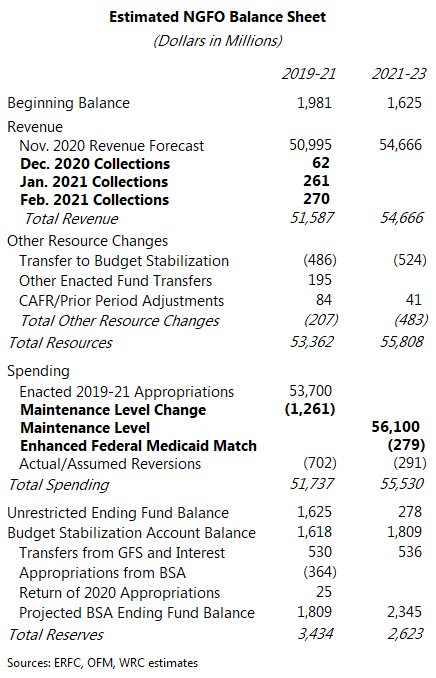8:39 am
March 4, 2021
As I wrote earlier this week, the American Rescue Plan Act that was passed by the U.S. House on Saturday would send billions of dollars to Washington (if enacted). Two major pieces of the legislation are the coronavirus state and local fiscal recovery funds (sec. 5001).
The Tax Foundation estimates that, if the bill is enacted, the state of Washington will receive $4.285 billion from this fund. On top of that, local governments in Washington will receive $2.435 billion. (The local portion will be split evenly between cities and counties; the National Association of Counties has a slightly different estimate.)
These funds are more flexible than the Coronavirus Relief Fund (the CRF was part of the CARES Act; Washington’s state and local governments received $2.953 billion). They could be used to respond to or mitigate the public health emergency, cover costs incurred as a result of the emergency, address negative economic impacts from the emergency, and replace revenue (based on the forecast as of Jan. 27, 2020). As I noted earlier, it looks like $1.226 billion of the state’s share could be transferred to the general fund–state to replace revenues that were expected in the November 2019 forecast but not in the November 2020 forecast, through 2021–23. (The March forecast could reduce that figure.)
Additionally, there does not appear to be a time limit on use of the funds. (By contrast, states must use their CRF dollars by Dec. 31, 2021.)
In my post earlier this week, I linked to Jerry Cornfield’s story that estimated that federal grants to Washington would increase by at least $7.6 billion. That includes Washington’s share of the coronavirus state fiscal recovery fund and funding for public schools, higher education, child care, and Head Start. Add in the coronavirus local fiscal recovery fund amounts for Washington’s cities and counties and we’re up to about $10 billion.
But that figure does not include new public health funding. The new federal bill includes billions of dollars for public health, including for testing, vaccines, and community health centers. While the bill doesn’t specify how much of that will ultimately flow to Washington, it will certainly be significant. (The Committee for a Responsible Federal Budget estimates that governments and organizations in Washington have received $3.96 billion specifically for health spending from previously enacted federal COVID-19 legislation.)
Washington’s share of the coronavirus state fiscal recovery fund could also be used to address public health costs. Indeed, the state used some of its share of the CRF for health expenses. According to the Pandemic Response Accountability Committee, through Dec. 31, 2020, the state spent $291.3 million on medical expenses and $995.2 million on public health expenses from its share of the CRF.
Meanwhile, earlier this year the Biden Administration told governors that the enhanced federal Medicaid match will remain in effect through at least the end of CY 2021. These matching funds directly supplant state funding for Medicaid. Our most recent balance sheet includes an estimate of the impact of this policy on the state budget. Although revenues are currently expected to be less than forecast in November 2019 (and February 2020), the current budget balances over four years—without increasing taxes or tapping the rainy day fund.

Tags: ARP Act , CARES Act , COVID-19 , other federal action on COVID-19
